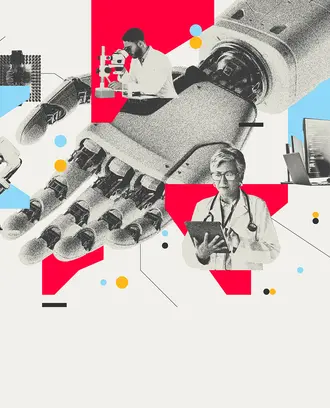Credit: Israel Vargas
Digital transformation. Automation. Globalization. A persistent productivity-wage gap — and the anger and activism it can engender in the workforce.
Those are just a few of the headwinds buffeting business leaders as they try to set a course for the work of the future. And that’s before accounting for pandemic-related shocks like supply chain disruptions, inflation, and the changing norms around hybrid work and geolocation.
Business leaders “need to build strong companies and good jobs in a globally competitive economy where technology is advancing, with the social diversity we find in our world.” That’s how MIT Sloan professor of managementintroduces his online executive education course, “Leading the Future of Work.”
Across industries, workers are worried that automation and artificial intelligence will steal their jobs, said Kochan, a member of the MIT Task Force on Work of the Future. Kochan shares those concerns, but also sees “tremendous” innovative potential in new technologies.
“We believe that we can harness advancing technologies to create a productive and more equitable future,” he said.
Another challenge is addressing the gap between productivity and wages that has been growing since the 1980s, when wages stagnated for average American workers even as productivity increased.
In the U.S., nine out of 10 people born between the 1940s achieved a higher income and a higher standard of living than their parents. In contrast, only half of people born after 1980 have been able to achieve a standard of living that’s higher than what they grew up with.
Globalization, the presence of the “informal economy” of jobs without a social safety net, and the decline of union membership has led to “an imbalance of power at work that needs to be addressed,” Kochan said.
A “new social contract”
In his book with Cornell professor Lee Dyer, “Shaping the Future of Work: A Handbook for Action and New Social Contract,” Kochan describes a new social contract as a “collaborative effort to develop high-quality jobs and strong, successful businesses while overcoming the deep social and economic divisions apparent in society today.”
In his course, Kochan lays out a four-pronged roadmap to guide business leaders in creating this model for work of the future:
1. Lead with “the high road.”
Businesses leaders have a choice in how they compete and create value for investors, employees, and customers. A low-road approach focuses on fast returns to shareholders and a view that the workforce is a place to cut costs.
Related Articles
Organizations embracing high-road principles lean into innovation, strong customer services, and fair pricing. Most importantly, they strive to create value for all stakeholders, including their employees.
“A high-road company invests in workforce development and engages employees in improving operations, introducing new technologies and work processes, and sharing in the financial success employees help to generate,” Kochan said.
No single change or practice will put a company on the path to being a high-road player. Rather, Kochan said, it requires a coordinated system of practices that reinforce each other, as well as a commitment to changing culture.
Supporting diversity and inclusion principles when hiring and promoting, instilling zero tolerance for intimidation or discrimination, and nurturing a culture that values worker contributions and workers’ voices are among the go-to practices high-road companies embrace.
“By putting in place a full bundle of coordinated employment practices, you can attract and retain the best talent and use their skills and motivation to make your company successful,” Kochan said.
That includes tying worker compensation to profits, offering flexible work hours, and providing paid leave for care givers and parents.
2. Use advanced technology to drive innovation and augment work.
From AI to robots to cloud services and software, there’s no lack of technology available to drive innovation and competitive advantage. Deployed without consideration of the workforce, these technologies can displace workers or create bad jobs.
Related Articles
In light of the social contract, companies should engage workers at each stage of the design and implementation of new technology to ensure it actually delivers its intended benefits. Employees should be appropriately trained before the technology becomes central to their daily responsibilities, and those whose jobs are affected negatively should be compensated for their loss.
Yet that’s not how companies have traditionally introduced new technologies. Most follow a sequential model whereby a system is brought in to solve a business problem without involving day-to-day workers in defining the business problem or determining if they have the skills to fully utilize the technology and reap its benefits.
Kochan contends an integrated approach is far more effective. This model draws on engineers, vendors, and front-line employees closest to the business problem early on, working in concert to design the technology and work systems.
“When we integrate the design of technology and the design of work, evidence shows that we get the highest levels of productivity and more rewarding work,” Kochan said.
Even advanced analytics and AI demand engagement across all stakeholders in order to be successful.
“There’s a lot of fear around AI and robots, but they need to be positioned as tools to help people think,” saidan MIT Sloan professor of information technology who co-teaches the executive education course with Kochan. “When you build tools with that in mind, people are quite accepting of them. That multistakeholder view is really important when it comes to minimizing risk.”
3. Train and upskill the workforce.
Ensuring the workforce is ready to participate in the future of work is a principal tenet of the new social contract. Kochan emphasizes employing state-of-the-art learning systems that make full use of all online resources available.
Training and skills building also needs to be a continuous process that is agile enough to shift as the methods and content change over time. This also ensures workers have keen understanding of their jobs so they can augment ongoing AI and automation efforts with their knowledge and expertise to achieve better outcomes.
Beyond any one organization’s role, it’s important to build lifelong ecosystems in partnership with industry peers, the education sector, and workforce development institutions. In education, in particular, it’s crucial to look beyond K – 12 or even four-year college to other tracks that can help workers upgrade skills, including workforce boards or community colleges.
“The U.S. is extremely good at college education with some of the world’s best universities, but it dramatically underinvests in anything that’s not based in college,” said David Autor, a professor of economics at MIT and the co-director of the MIT Task Force on Work of the Future. “We have weak vocational systems to the degree that labor unions did a lot of the apprenticeship training that has atrophied as labor union coverage has fallen substantially.”
4. Engage workers as partners in innovation.
Today’s workforce has high expectations for having a meaningful voice at work, and they want to choose the best mechanism to address their particular needs and circumstances, particularly around new technologies and disruptions like the global pandemic.
Leadership should strive to develop new safe channels of communication and put mechanisms in place for prompt response — a feedback loop that builds mutual trust, Kochan said.
Engaging workers as partners requires new management styles built on collaboration and open dialogue. Younger generations are dissatisfied with a hierarchical approach to management and will seek out employers who engage them collaboratively. As part of the transition to a new style of leadership, there should be a focus on active listening and facilitative behaviors that elicit different viewpoints and encourage all participants to engage.
At the same time, business leaders need to play a key role in rebuilding dialogue with labor leaders in their communities and industries. Engagement with others outside of the internal organization is the best way to build a more inclusive social contract and empower a future of work that works for everyone, Kochan said.
“Business and labor can lead the way in showing how some of the deep-seated divisions that now threaten our democracies can be addressed in mutually respectful and effective means,” Kochan said. “That is the kind of leadership that is needed if we are to build a new social contract that works for all in the years ahead.”
Read next: Why distributed leadership is the future of management



